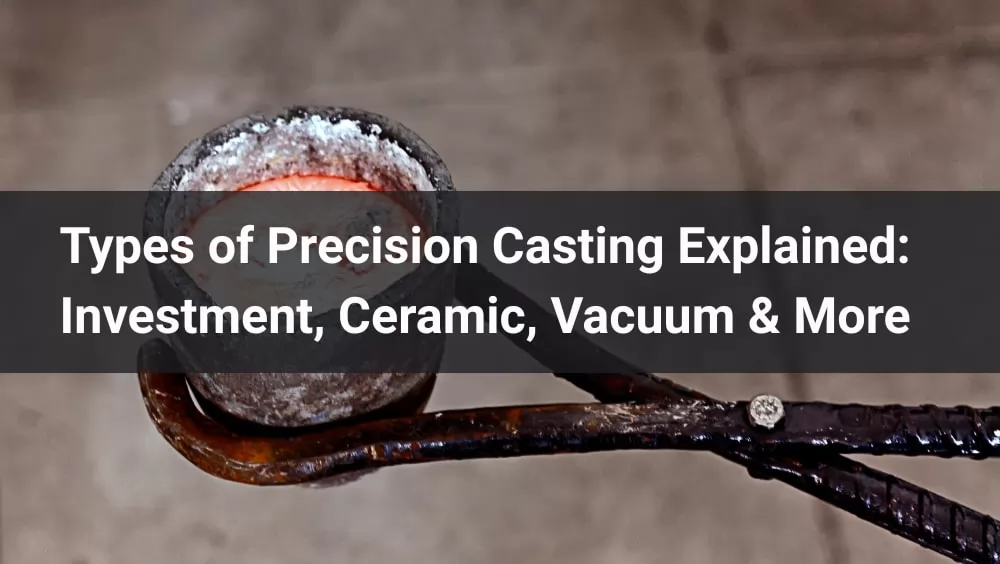
Precision casting isn’t a one-size-fits-all process—it's a diverse field with multiple casting types, each tailored to meet specific industrial needs. From investment casting for intricate geometries to vacuum casting for high-purity alloys, understanding these options is key to making the right manufacturing choice. But with so many methods available, how do you know which one fits your project best?
Whether you’re designing high-performance aerospace parts or durable components for the energy sector, choosing the correct casting type can affect everything from cost and lead time to part strength and surface quality. In this guide, we’ll break down the most common types of precision casting, explaining how each one works and when to use them—so you can make informed decisions based on real production needs.
Table of Contents
- What Is Precision Casting? A Quick Overview
- Precision Casting Type
- Choosing the Right Precision Casting Type
- Environmental & Economic Considerations
- FAQs: Precision Casting Methods
- Conclusion: Precision Casting, Tailored to Your Needs
What Is Precision Casting? A Quick Overview
Precision casting, also known as investment casting or lost-wax casting, is a manufacturing process used to produce highly accurate, complex metal parts. Unlike traditional casting techniques, precision casting achieves near-net-shape products with minimal machining and excellent surface finishes. It's especially useful for industries like aerospace, automotive, medical, and energy, where tight tolerances and intricate geometries are essential.
Whether you're building jet turbine blades or dental implants, precision casting offers repeatability, scalability, and superior detail—making it a trusted solution across a wide range of applications.
Precision Casting Types
| Type | Main Features | Advantages | Best Applications |
|---|---|---|---|
|
Investment Casting (Lost-Wax Casting) |
Wax model + ceramic shell + molten metal filling |
- High accuracy - Complex geometry - Minimal waste |
Turbine blades, gears, orthopedic implants, aerospace parts |
| Ceramic Shell Casting | Advanced ceramic mold for high-temp metals |
- Higher shell strength - Better for large parts - Enhanced surface finish |
Large stainless steel parts, energy equipment, superalloys |
| Vacuum Casting | Casting under vacuum to avoid oxidation and porosity |
- High purity and density - Great surface finish - Suitable for reactive metals |
Titanium components, aerospace, medical implants |
| Centrifugal Casting | Spinning mold uses centrifugal force to shape metal |
- Strong internal structure - Low defect rate - Ideal for hollow parts |
Pipes, bushings, rings, cylinders |
|
Die Precision Casting (High-Pressure Die Casting) |
Molten metal injected into steel mold under pressure |
- Fast cycle time - Consistent finish - Ideal for mass production |
Automotive parts, appliance housings, consumer electronics |
1. Investment Casting (Lost-Wax Casting)
Investment casting is the most widely used and versatile form of precision casting. The process begins with the creation of a wax replica of the final part. This wax model is dipped into a ceramic slurry and coated multiple times with fine refractory materials to build a durable shell. Once the shell is fully dried, the wax is melted out ("lost wax"), and molten metal is poured into the mold.
Key Benefits:
- Exceptional dimensional accuracy and repeatability
- Suitable for complex geometries, thin walls, and intricate details
- Minimal material waste due to near-net shape production
- Supports a wide variety of ferrous and non-ferrous alloys
Common Applications: Turbine blades, orthopedic implants, gears, brackets, medical tools, and precision-engineered parts across aerospace, automotive, and industrial sectors.
2. Ceramic Shell Casting
Ceramic shell casting is a refined subset of investment casting that uses advanced ceramic materials to construct the mold. This method provides better shell integrity and can withstand higher casting temperatures, making it ideal for superalloy and stainless steel applications. The process is similar to traditional investment casting but emphasizes improved shell strength, thermal resistance, and surface finish.
Why Use It?
- Superior mold strength for large and heavy parts
- Consistent results for high-melting-point alloys
- Enhanced dimensional stability during metal pouring
Best For: Large stainless steel components, superalloy turbine casings, and structural parts used in energy, heavy equipment, and industrial machinery.
3. Vacuum Casting
Vacuum casting is employed when extreme purity and precision are required. By performing the casting process in a vacuum chamber, it minimizes air entrapment and oxidation, producing denser, stronger parts with fewer defects. This is particularly important for reactive metals like titanium or specialty aluminum alloys.
Advantages:
- Near-complete elimination of gas porosity
- High-quality surface finish and microstructure
- Suitable for aerospace-grade metals and medical applications
Industries Served: Aerospace, military defense, high-performance automotive, and implant-grade medical device manufacturing.
4. Centrifugal Casting
Centrifugal casting involves rotating the mold at high speed while pouring molten metal into it. The centrifugal force distributes the metal evenly and forces impurities to the outer edges, where they can be easily removed. This technique is ideal for producing cylindrical or symmetrical hollow components with high structural integrity.
Strengths:
- Excellent metallurgical properties due to directional solidification
- Minimizes porosity and inclusions
- High yield and mechanical strength for tubular parts
Applications: Pipes, sleeves, bushings, gear rings, cylinder liners, and pressure-containing components for industrial and marine use.
5. Die Precision Casting (High-Pressure Die Casting)
High-pressure die casting forces molten metal into reusable steel molds (dies) under high pressure. It's known for its speed and ability to produce complex, high-volume parts with consistent quality. However, it is generally limited to non-ferrous metals like aluminum, zinc, and magnesium, and not suited for extremely intricate designs due to tooling limitations.
Key Features:
- Rapid production cycles ideal for mass manufacturing
- Excellent surface finish and dimensional repeatability
- Limited to metals with low melting points; less effective for high-alloy steels
Best Suited For: Automotive engine housings, electronic enclosures, power tool bodies, and mass-market consumer components.
Choosing the Right Precision Casting Type

Selecting the right casting method depends on multiple factors:
| Factor | Best Fit |
|---|---|
| Part Complexity | Investment or Ceramic Shell |
| Surface Finish Required | Vacuum Casting |
| High Volume | Die Casting |
| Cost Efficiency for Medium Runs | Centrifugal or Investment Casting |
| Material Purity | Vacuum Casting |
When selecting the right precision casting method, it’s important to assess your project’s specific requirements. For parts with intricate geometries or fine details, investment casting or ceramic shell casting is ideal due to their ability to produce complex shapes with high dimensional accuracy. If surface quality is a top priority—such as in aerospace or medical applications—vacuum casting ensures smooth finishes and minimal porosity, making it a strong candidate.
For high-volume production, die casting stands out with its fast cycle times and low per-unit costs, especially when working with aluminum or zinc alloys. Meanwhile, centrifugal casting offers cost-efficiency for medium production runs and is excellent for symmetrical, tubular parts. And when material purity matters—like with reactive metals or components requiring high strength—vacuum casting once again proves its value. Choosing the optimal process depends on balancing complexity, finish, volume, and material performance.
Pro Tip:
If you need tight tolerances and intricate features in stainless steel, investment casting is likely your best choice. For lightweight aluminum components in high volumes, go with die casting.
Environmental & Economic Considerations
Precision casting combines advanced manufacturing with sustainability and cost-efficiency, making it increasingly attractive in modern production environments. Understanding these environmental and economic factors helps businesses better plan their production processes, achieving a win-win in green manufacturing and cost control.

Environmental Pros:
- Reduced Material Waste: Precision casting produces parts very close to their final dimensions (near-net shape), significantly minimizing excess metal usage and scrap compared to traditional machining. This efficient use of raw materials lowers environmental impact by conserving resources.
- Lower Energy Consumption: Compared to subtractive methods like CNC machining, which remove large amounts of material, precision casting consumes less energy overall. The process relies on molding and pouring rather than extensive cutting, reducing carbon footprint per part.
- Recyclable Materials: Many of the materials used, including wax patterns and ceramic shells, can be recycled or reused. Waxes can often be reclaimed and remelted, and ceramic shell materials can sometimes be crushed and recycled as refractory material, reducing landfill waste.
- Cleaner Production: Modern foundries increasingly adopt eco-friendly technologies such as advanced filtration systems, low-emission furnaces, and closed-loop water recycling, further reducing pollution and environmental footprint.

Economic Considerations:
- Higher Initial Tooling Costs: The upfront investment in creating precise wax patterns, ceramic molds, and tooling can be substantial—especially for complex designs or die casting. This initial cost is a key factor to consider, especially for low-volume projects.
- Cost Efficiency in Medium to Large Runs: Once tooling is established, the per-unit cost decreases significantly as production volume increases. Precision casting offers a balance of quality and economy that is hard to beat for medium-volume runs where mass production is not yet justified.
- Reduced Post-Processing Expenses: Since precision casting delivers parts with excellent surface finish and tight tolerances, the need for additional machining, grinding, or finishing is minimized. This leads to savings in labor, materials, and time downstream.
- Sustainability as a Competitive Advantage: With rising regulatory pressures and consumer demand for greener products, companies adopting precision casting with sustainable practices position themselves better in the market. Energy-efficient kilns, water recycling systems, and waste recovery not only help comply with regulations but also enhance brand reputation.
In conclusion, precision casting is not just a manufacturing choice but also a strategic environmental and economic decision. By leveraging its material efficiency and potential for sustainable production, businesses can reduce costs while supporting green initiatives. For projects where quality, complexity, and sustainability intersect, precision casting stands out as an intelligent solution.
If you want to explore how Besser's precision casting services can deliver cost-effective, environmentally friendly solutions tailored to your needs, feel free to reach out. We combine cutting-edge technology with sustainability best practices to help you succeed.
FAQs: Precision Casting Methods

What is the main difference between investment and ceramic shell casting?
Investment casting uses wax and a standard ceramic mold; ceramic shell uses advanced refractory ceramics for higher precision and heat resistance.
When should vacuum casting be used?
Vacuum casting is ideal for reactive metals like titanium or aluminum that are sensitive to oxidation during the pouring process.
Is centrifugal casting only for round parts?
Yes, centrifugal casting is best for symmetrical, tubular, or cylindrical shapes like pipes, rings, and bushings.
Which casting method is best for high-volume production?
High-pressure die casting is most suitable for large-scale manufacturing, especially with non-ferrous metals like aluminum or zinc.
Can multiple precision casting types be combined in one project?
In some cases, yes—especially for projects with varied part geometries or material requirements. Consult with a casting expert for evaluation.
Conclusion: Precision Casting, Tailored to Your Needs
Each casting method—investment, ceramic shell, vacuum, centrifugal, and die casting—brings unique advantages depending on your material, geometry, and performance requirements. The right choice can improve product quality, reduce post-processing, and keep your costs under control.
If you’re still unsure which process suits your project, it helps to consult with experienced professionals. At Besser, we specialize in a range of precision casting solutions and can help you navigate the best-fit process from design to delivery. Let’s build precision together.



